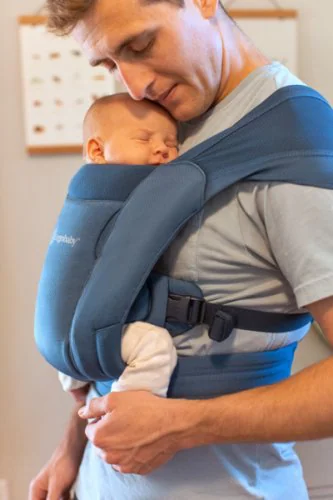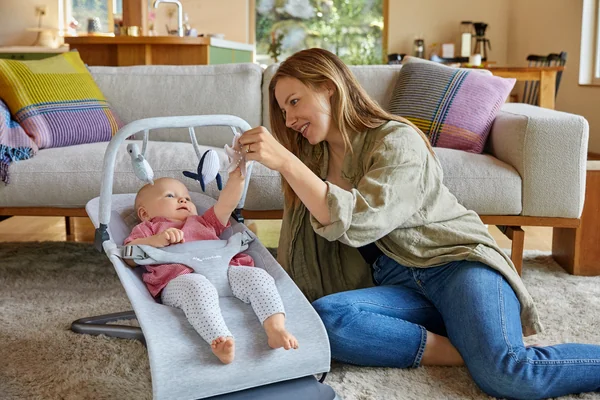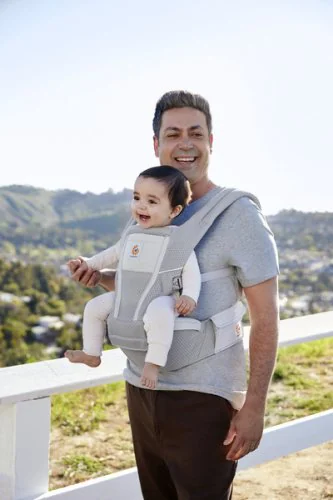Everything you need to know from the newborn to toddler years!
The first few years of your child’s life are wonderful, tiring and filled with so much growth. From developmental milestones to knowing what baby gear and toys are right for each age and stage, here’s everything you need to know about newborns, infants and toddlers, and supporting your child’s development at home.
Newborn
Your baby is considered a newborn from birth until about 2 months of age. In this stage, while you may be exhausted and you’re not sure if it’s day, night, Sunday or Friday, a LOT happens in the development of your baby’s brain and body. Many experts suggest that you think of a baby’s gestation as lasting eighteen months - nine months inside the womb and at least nine more months outside the womb.

Here are some Newborn Milestones you can look forward to:
-
Week 1: Your newborn can recognize familiar voices – mainly mom, dad and siblings.
- How you can help: The best ways to support your newborn in their first week of life are to talk to them and hold them! Remember the idea that gestation is 18 months. Keep your newborn close to you, so they can hear your voice, your heart beat, your steady breathing – these are all benefits of an ergonomic baby carrier that will not only comfort them, but help them grow!
-
Week 2: Your newborn can focus on objects that are about 8-14 inches away from their face.
- How you can help: Move your head during feedings to see if their eyes follow. You can also move and shake age-appropriate toys that make noise to see if baby will follow the toy. Don’t worry too much about getting them to engage with toys, they’re still young. The idea is that they’re beginning to see more in the world around them. Having them in a carrier is another great way to foster this development.
-
Weeks 3-4: Your newborn will start to snuggle and find their little voices.
- How you can help: Use a baby carrier! Lots of skin-to-skin will reinforce your bond. Repeat their cooing sounds back to them and continue talking to them about everything and anything!
-
1 Month (weeks 5-8): Your newborn’s jerky movements become smoother and more purposeful. They start smiling and may start understanding different senses and colors, and start lifting their head.
- How you can help: Practice small and safe body movements with them. Give them lots of smiles, supervised tummy time, and play with colorful toys with a variety of textures.
Essential Newborn Baby Gear and Toys
- Car seat
- Bassinet (some prefer this for room-sharing instead of putting right into a crib in the nursery)
- Newborn baby carrier
- Baby bathtub
- White noise machine
- Swaddles and other baby sleep products
- Nursing pillow
- Bottles
- Dummy
- Evolve 3-in-1 Bouncer
- Simple toys like books and rattles

Infant
Some say infancy starts at birth, while others say it begins at 2 months. But it’s agreed upon that infancy ends at 1 year of age. From 2 months until 1 year, a lot happens with your little one. Something important to note when tracking your baby’s milestones is that every baby is different. One child might crawl at 6 months and another might not begin crawling until 9 months. If you’re concerned that your child isn’t hitting their milestones, talk to your healthcare provider.
Here are some Infant Milestones you can look forward to:
-
More “talking”/babbling/noise-making, improving their social skills, experimenting with their hands, laughing, hand-eye coordination, mobility (rolling, crawling, sitting up and walking), pointing, expressing their big emotions, receptive language, eating solid foods, mastering their fine motor skills
- How you can help: Keep talking to your baby using different tones and pitches and making eye contact; have them around social settings (that you feel comfortable with); offer plenty of toys for them to feel, grab, play with and chew on; tummy time; read to your baby and label/point out things and tell them the correct names; help your baby learn to crawl, sit up, stand and walk; let them try eating solid foods with your help then on their own; play peek-a-boo; set objects they want away from them to encourage reaching, crawling and walking; sing and play music
Essential Infant Gear and Toys
- Stroller
- Baby monitor
- Baby-proofing stuff (safety gate, outlet covers, draw and door latches, etc.)
- Baby spoon
- Baby carrier
- Play mat or play yard
- High chair
- Push-pull toys
- Bouncer seat
- Books
- Soft toys like soft blocks
- Musical toys
- Balls
- Activity center
- Teething toys

Toddler
What is a toddler? A toddler is between the ages of 1-3 years old. According to the CDC, 3-5 year olds are considered preschoolers. As much as we would all love a guide book on our kiddos, there just isn’t one. Once you think you’ve figured your child out, something changes. And there isn’t a child out there that is “by the book”. Meaning, with all the research you do about milestones, parenting, and more – your kid is your unique kid. Child developmental milestones are exciting and fun to enjoy when you reach them. Don’t put too much pressure on yourself or your child. Enjoy your toddler for who they are and take every day in stride.
Here are some Toddler Milestones to look forward to:
-
1 year old: Your toddler will begin walking and talking. They can learn and use sign language, wave, understand certain phrases (like no), drink from a cup, put toys in a container, stack toys, feed themself with fingers and/or spoon, scribble, and climb up and down furniture without your help.
- How you can help: Narrate things you and your child are doing throughout the day. Teach your child good/positive behavior, build on their talking, clap, have them copy you, encourage them to follow simple one-step directions, and encourage pretend play.
-
2 years old: At this age, your toddler will point to things when asked, and use more gestures. They can put at least 2 words together and may start talking in short sentences! They can recognize and point to body parts, notice when people are upset or hurt, play with more than one toy at a time, hold something in one hand while using the other hand to do something else, run, use a spoon to eat, start showing problem-solving skills, and jump off the floor with 2 feet.
- How you can help: Help your child learn the correct way to say words and encourage them to put simple phrases together. Show and help your child play and share with others, and let your child help with small tasks around the house.
-
3 years old: Your toddler joins into play with other kids, can calm themselves in a short amount of time, and can have simple conversations with people. They ask questions, can learn and say their name, can dress themselves, and use a spoon and fork.
- How you can help: Encourage them to solve their own problems (as difficult as this might be for you!). Help them learn what their emotions are and how to positively handle them. Set rules they can follow, take them to the park, toddler classes, etc. where they can safely interact with other kids their age. Sing songs and play simple games with them.
Essential Toddler Gear and Toys
- Hip seat
- Step stool
- Convertible car seat
- Toddler bed
- Baby plates, bowls and utensils
- Sippy cups
- Little kid/travel potty or potty seat
- Crayons and colouring books
- Things to build with
- Age-appropriate puzzles and sorting sets
- Toys to play pretend with
- Stacking rings
Remember that most developmental milestones are used as a guide. Every baby is different, so every baby will grow and develop at his or her own rate. If your baby was born prematurely, your pediatrician may use an adjusted age based on your baby’s due date when evaluating certain developmental milestones to provide them more time to reach those milestones, which your baby may or may not need. But no matter when your baby was born, there are so many things you as their parent can do and use to help your baby and toddler learn and grow at a healthy rate. And remember, if you ever have any questions or concerns about where your child is at, your pediatrician is always there to help.
